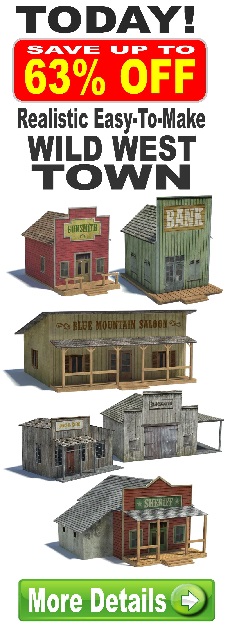Everything on model trains, model railroads, model railways, locomotives, model train layouts, scenery, wiring, DCC and more. Enjoy the world's best hobby... model railroading!
240V 10amp Extension Cord Wire on Model Railways?
Phillip moderls OO gauge and asks:
What’ the correct wire thickness?
“I have plenty of 240V 10amp extension cords in my shed. I was therefore wondering if the wire could be used for bus wires on a OO/HO DC model railway? Or, would the wire be too thick for the power going from the controller to the track?”
13 Responses to 240V 10amp Extension Cord Wire on Model Railways?
Leave a Reply
















That’s exactly what I used without any problems. Admittedly it is easier to hide the droppers if they are thinner wire, but it can be done with the 10A wire if you want.
240v at 10 amps is 2400 watts. At 12v DC this means that you could put 200amps through it without any problem which should be ample (as most locomotives take 0.5 amps or less)!
A wire can never be too thick, only too thin so you’re good to go.
NO power is not the issue–it is current so you can run 10A no matter the voltage. That is who transmission lines use such high voltage–lots of power (watts) without having to have thick wire.
Transmission lines transmit AC and not DC. AC transmission does not need heavy gauge wire for the same voltage/current as for DC.
As for the original question, the heavier the cable is, the better it is as there will be less resistance and therefore less voltage drop. But, you have to consider if it is overkill for the job so that it is not an eyesore even for yourself (as the outsiders will not see what you have done below the boards).
The thicker the wire, the lower the resistance and the more current it can take. In terms of carrying power, a wire can’t be too thick. Of course, thicker wire is heavier, doesn’t bend as well, and takes up more space.
However, in case of a short circuit, more power can go through the thicker wire. I’ve read that if you use wire that is too thick when wiring a house, if there was a short circuit, the amount of power could cause arcing at the circuit breaker, and therefore the circuit breaker would not work to cut the power. I wouldn’t think that would be a problem with DCC, but I would think you would need to consider some sort of circuit protection.
NO heavy wire doesn’t cause arcing–the breaker trips regardless of the wire size.
I suspect your extension cords will have stranded wire in them and the wires may be twisted. If so it will be difficult to make any sort of quick connect to them. Probably better to use standard electrical service wire which has solid wires each of which will be identified on the outside of the wire.
As for the second part of your question: the thicker the wire (the lower the number – heavier the gauge) the more amps it will carry without overheating.
Those would be ok for the bus wires but would be too large for feeders to the track. The larger wires are actually better for bus wires, especially on a large layout since there would be less loss,
iN TRYING TO USE YOUR 240 VOLTS 10AMP EXTENION CORDS TO WIRE YOUR LAYOUT IS NOT RECOMENED. THEREFORE I RECOMEND THAT YOU SHOULD WIRE YOUR LAY WITH A NUMBER 8 OR 10 WIRE STRANDARD. cHECK WITH YOUR LOCAL HOBBY SHOP GIVE THEM
THE VOLTAGE AND AMPS USEING YOUR LOCAMOTIVES OR YOUR TRANSFORMER INFORMATION THEY SHOULD TELL YOU THE SIZE OF WRING YOU SHOULD USED.
Mains wire is fine except if you mistake a mains feed for a bus and get electrocuted. Stranded is easier to solder to than solid conductors. Conventional wisdom says you can’t use too big a wire, well actually you can, and the bigger the bus the more awkward to solder tp, and the more need to support it and more hassle to get round corners
I guess you are thinking to strip the out of the casing and using each conductor separately as a buss wire. The comment about dropping a large amount of current and welding a circuit breaker closed is a possibility, but is not a concern in a low voltage model train environment. Regardless of the size of the wire, the current cannot exceed the capability of the supply. Will the power supply be destroyed? Maybe if not properly fused. I say fused because a large current draw will not be able to jump across a long fuse (3AG?) in a low voltage system. You need high voltage (like thousands of volts to jump a 1 inch gap) to do that. Also there are no contacts that can weld and stay connected. ALL THAT BEING SAID: I would buy mating connectors and wire to them and not destroy the extension cord, If you are running control signals in the cord, there could be crosstalk between the wires in the casing so be aware of that if you start having unexplained control issues.
Norman, no need to shout mate. Normal 3 core house wire is ideal for bus wires on a layout. It’s a bit too heavy for droppers, but if you’ve got the time, and lots lying around, create your own by using the unsheathed earth wire but don’t forget to insulate it with paint on plastic or Polyurathane varnish before use.
One main thing you need to do is make sure you use one color for all Bus Wires of the same polarity, i.e., plus & minus, whether DCC or DC, so if the wires are the same color (as in Zip Cord/Lamp cables), you need to tag them every foot or so so you don’t cross them up & inadvertently short them. Also different colors for Track Power & Accessary Power. Also if you use multiple extension cables to supply the wire, connect all the same color for each Bus.